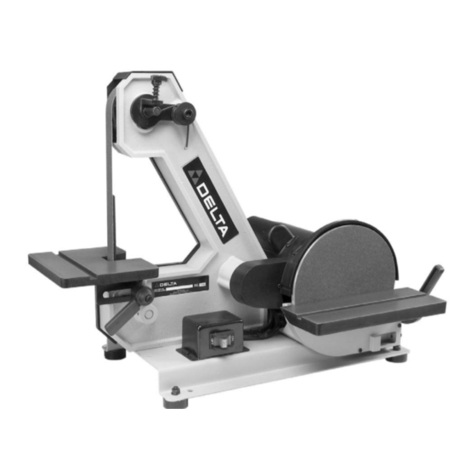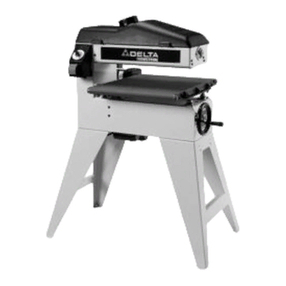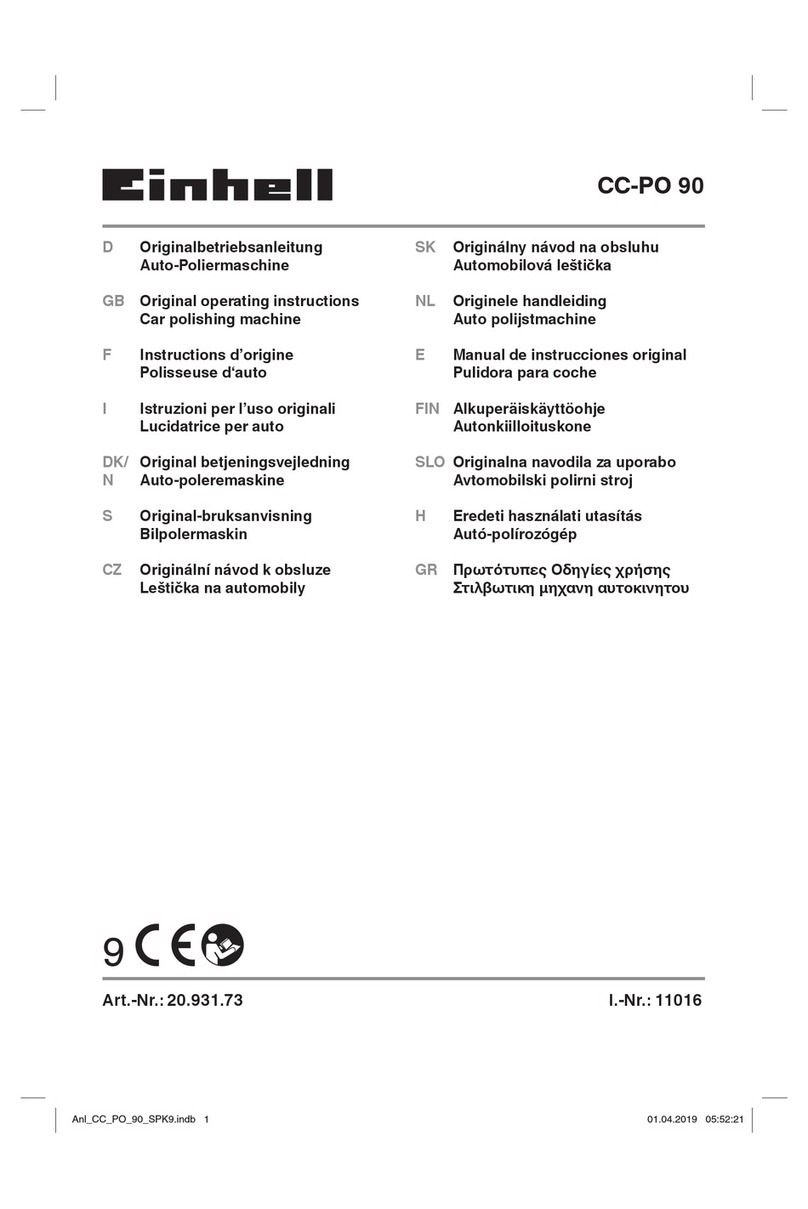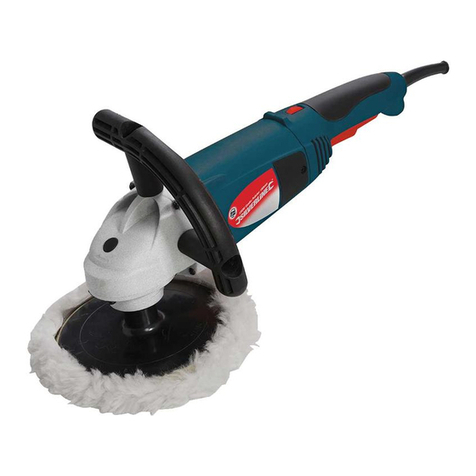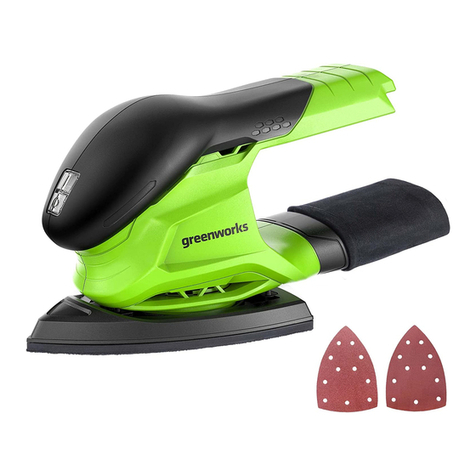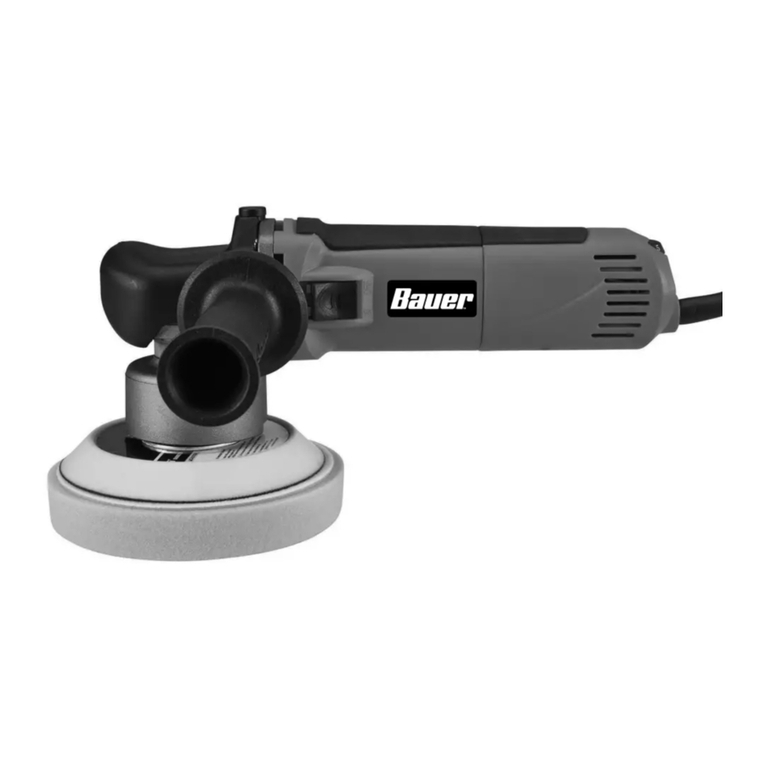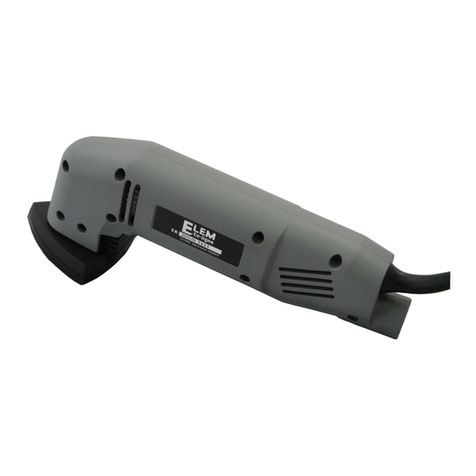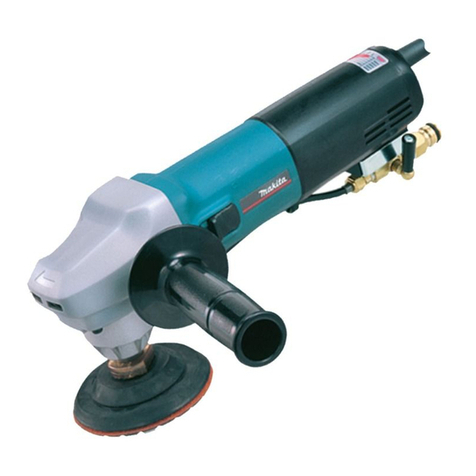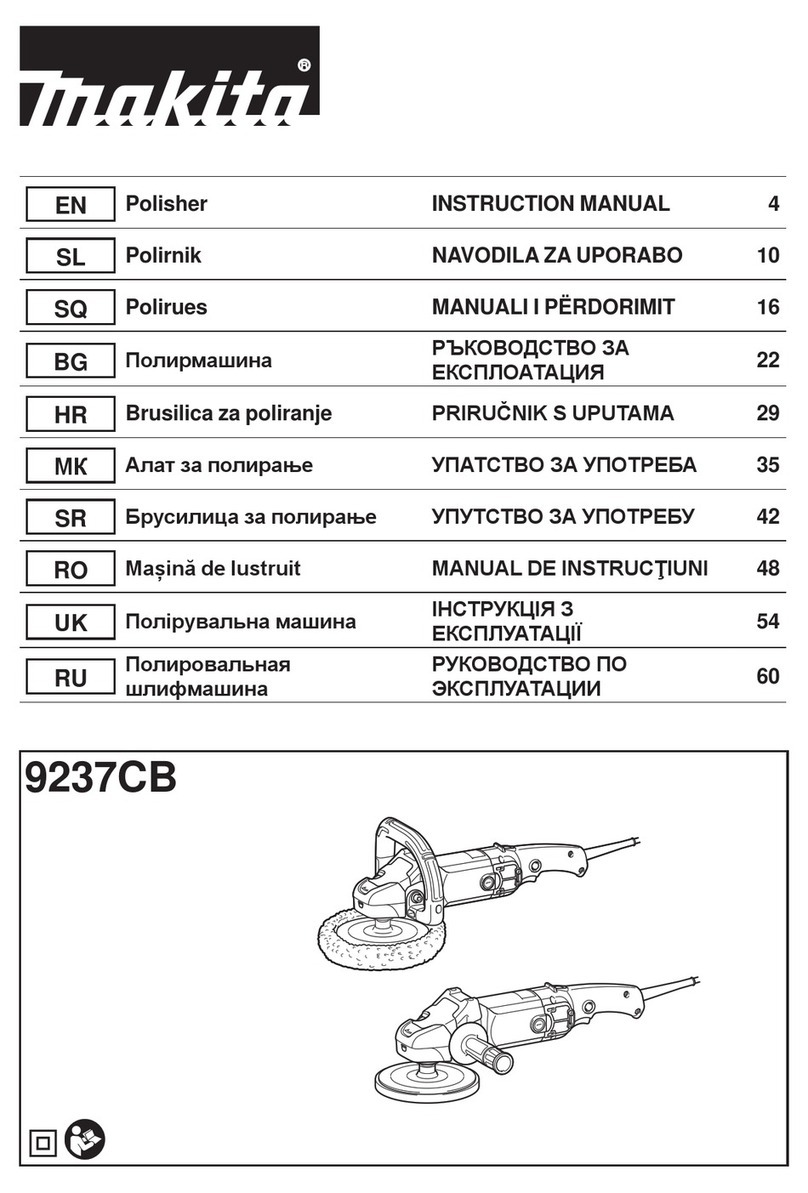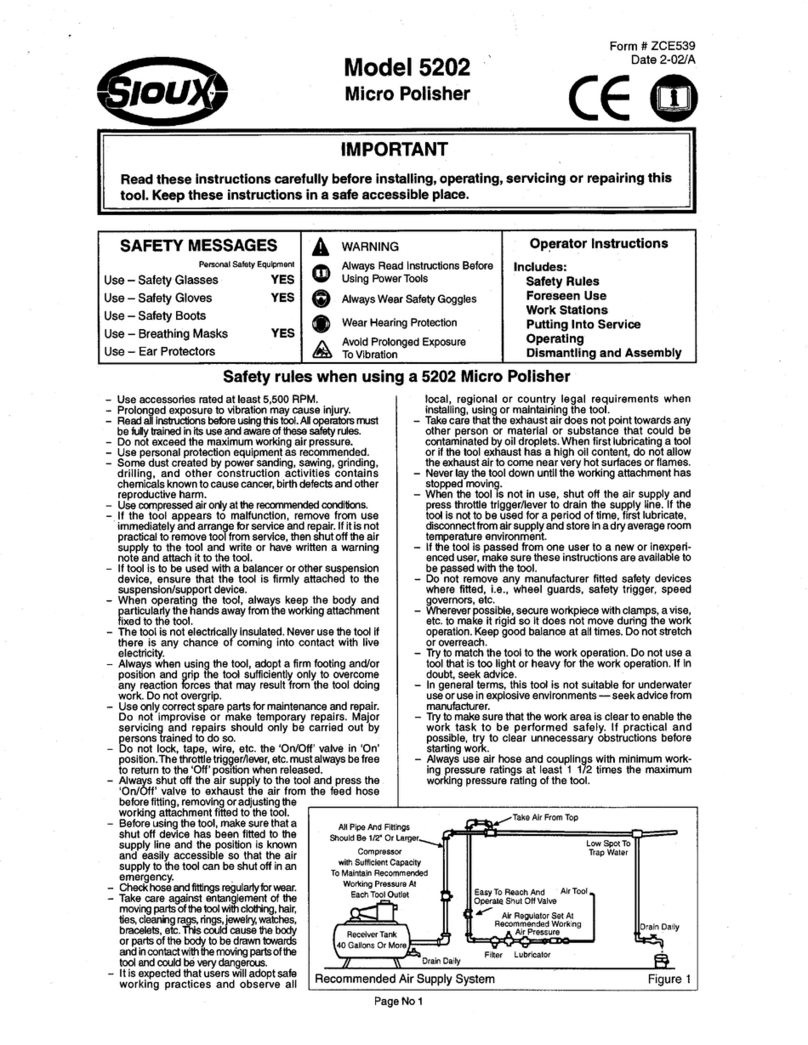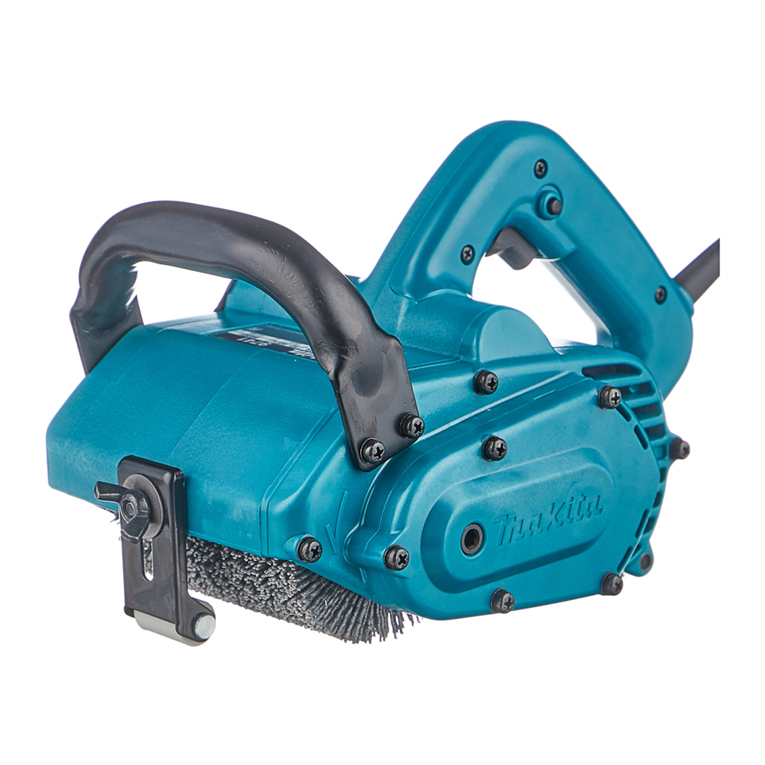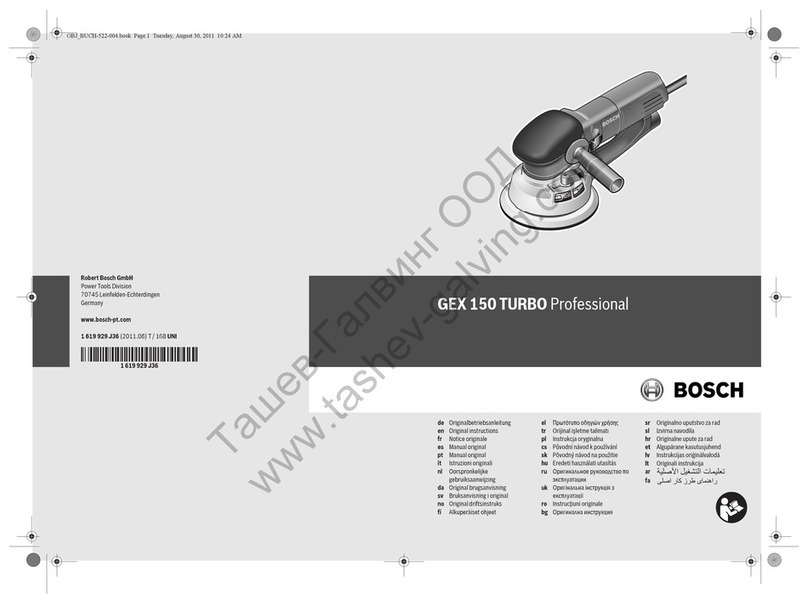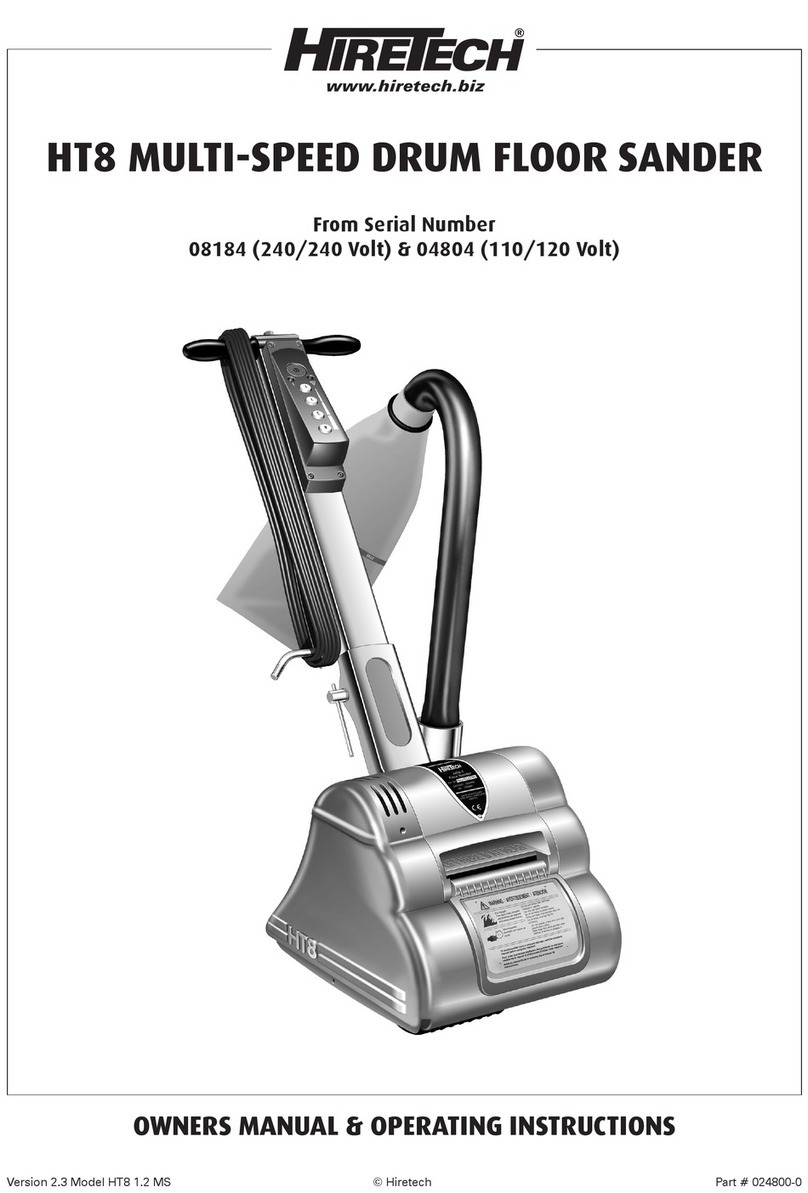Delta B.O.S.S. SA350 User manual

INSTRUCTION MANUAL
Bench Oscillating Spindle
Sander
(Model SA350)
PART NO. 906118 - 06-15-02
Copyright © 2002 Delta Machinery
ESPAÑOL: PÁGINA 13
To learn more about DELTA MACHINERY
visit our website at: www.deltamachinery.com.
For Parts, Service, Warranty or other Assistance,
please call 1-800-223-7278 (In Canada call 1-800-463-3582).
33952
RTD10000124AA

2
GENERAL SAFETY RULES
Woodworking can be dangerous if safe and proper operating procedures are not followed. As with all machinery, there
are certain hazards involved with the operation of the product. Using the machine with respect and caution will
considerably lessen the possibility of personal injury. However, if normal safety precautions are overlooked or ignored,
personal injury to the operator may result. Safety equipment such as guards, push sticks, hold-downs, featherboards,
goggles, dust masks and hearing protection can reduce your potential for injury. But even the best guard won’t make
up for poor judgment, carelessness or inattention. Always use common sense and exercise caution in the workshop.
If a procedure feels dangerous, don’t try it. Figure out an alternative procedure that feels safer. REMEMBER: Your
personal safety is your responsibility.
This machine was designed for certain applications only. Delta Machinery strongly recommends that this machine not
be modified and/or used for any application other than that for which it was designed. If you have any questions relative
to a particular application, DO NOT use the machine until you have first contacted Delta to determine if it can or should
be performed on the product.
Technical Service Manager
Delta Machinery
4825 Highway 45 North
Jackson, TN 38305
(IN CANADA: 505 SOUTHGATE DRIVE, GUELPH, ONTARIO N1H 6M7)
WARNING: FAILURE TO FOLLOW THESE RULES MAY RESULT IN SERIOUS PERSONAL INJURY
1. FOR YOUR OWN SAFETY, READ INSTRUCTION
MANUAL BEFORE OPERATING THE TOOL. Learn the
tool’s application and limitations as well as the specific
hazards peculiar to it.
2. KEEP GUARDS IN PLACE and in working order.
3. ALWAYS WEAR EYE PROTECTION.
Wear safety
glasses. Everyday eyeglasses only have impact resistant
lenses; they are not safety glasses. Also use face or dust
mask if cutting operation is dusty. These safety glasses
must conform to ANSI Z87.1 requirements. NOTE:
Approved glasses have Z87 printed or stamped on them.
4. REMOVE ADJUSTING KEYS AND WRENCHES. Form
habit of checking to see that keys and adjusting wrenches
are removed from tool before turning it “on”.
5. KEEP WORK AREA CLEAN. Cluttered areas and
benches invite accidents.
6. DON’T USE IN DANGEROUS ENVIRONMENT. Don’t
use power tools in damp or wet locations, or expose them
to rain. Keep work area well-lighted.
7. KEEP CHILDREN AND VISITORS AWAY. All children
and visitors should be kept a safe distance from work area.
8. MAKE WORKSHOP CHILDPROOF – with padlocks,
master switches, or by removing starter keys.
9. DON’T FORCE TOOL. It will do the job better and be
safer at the rate for which it was designed.
10. USE RIGHT TOOL. Don’t force tool or attachment to
do a job for which it was not designed.
11. WEAR PROPER APPAREL. No loose clothing, gloves,
neckties, rings, bracelets, or other jewelry to get caught in
moving parts. Nonslip footwear is recommended. Wear
protective hair covering to contain long hair.
12. SECURE WORK. Use clamps or a vise to hold work
when practical. It’s safer than using your hand and frees
both hands to operate tool.
13. DON’T OVERREACH. Keep proper footing and
balance at all times.
14. MAINTAIN TOOLS IN TOP CONDITION. Keep tools
sharp and clean for best and safest performance. Follow
instructions for lubricating and changing accessories.
15. DISCONNECT TOOLS before servicing and when
changing accessories such as blades, bits, cutters, etc.
16. USE RECOMMENDED ACCESSORIES. The use of
accessories and attachments not recommended by Delta
may cause hazards or risk of injury to persons.
17. REDUCE THE RISK OF UNINTENTIONAL STARTING.
Make sure switch is in “OFF” position before plugging in
power cord.
In the event of a power failure, move switch
to the “OFF” position.
18. NEVER STAND ON TOOL. Serious injury could occur if
the tool is tipped or if the cutting tool is accidentally
contacted.
19. CHECK DAMAGED PARTS. Before further use of the
tool, a guard or other part that is damaged should be
carefully checked to ensure that it will operate properly and
perform its intended function – check for alignment of
moving parts, binding of moving parts, breakage of parts,
mounting, and any other conditions that may affect its
operation. A guard or other part that is damaged should be
properly repaired or replaced.
20. DIRECTION OF FEED. Feed work into a blade or
cutter against the direction of rotation of the blade or cutter
only.
21. NEVER LEAVE TOOL RUNNING UNATTENDED.
TURN POWER OFF. Don’t leave tool until it comes to a
complete stop.
22.
STAY ALERT, WATCH WHAT YOU ARE DOING, AND
USE COMMON SENSE WHEN OPERATING A POWER
TOOL. DO NOT USE TOOL WHILE TIRED OR UNDER
THE INFLUENCE OF DRUGS, ALCOHOL, OR
MEDICATION. A moment of inattention while operating
power tools may result in serious personal injury.
23. MAKE SURE TOOL IS DISCONNECTED FROM
POWER SUPPLY while motor is being mounted,
connected or reconnected.
24. THE DUST GENERATED by certain woods and wood
products can be injurious to your health. Always operate
machinery in well ventilated areas and provide for proper
dust removal. Use wood dust collection systems whenever
possible.
25.
WARNING: SOME DUST CREATED BY
POWER SANDING, SAWING, GRINDING, DRILLING,
AND OTHER CONSTRUCTION ACTIVITIES contains
chemicals known to cause cancer, birth defects or other
reproductive harm. Some examples of these chemicals
are:
· lead from lead-based paints,
· crystalline silica from bricks and cement and other
masonry products, and
· arsenic and chromium from chemically-treated lumber.
Your risk from these exposures varies, depending on how
often you do this type of work. To reduce your exposure
to these chemicals: work in a well ventilated area, and
work with approved safety equipment, such as those
dust masks that are specially designed to filter out
microscopic particles.
SAVE THESE INSTRUCTIONS.
Refer to them often and use them to instruct others.

ADDITIONAL SAFETY RULES FOR
OSCILLATING SPINDLE SANDERS
3
WARNING: FAILURE TO FOLLOW THESE RULES MAY RESULT IN SERIOUS PERSONAL INJURY.
SAVE THESE INSTRUCTIONS.
Refer to them often
and use them to instruct others.
1. DO NOT OPERATE THIS MACHINE until it is
assembled and installed according to the instructions.
2. OBTAIN ADVICE FROM YOUR SUPERVISOR,
instructor, or another qualified person if you are not
familiar with the operation of this machine.
3. FOLLOW ALL WIRING CODES and recommended
electrical connections.
4. KEEP fingers away from rotating sanding drum.
5. MAKE SURE sanding drum is not damaged and is
properly secured on the spindle before operating.
6. NEVER perform layout, assembly or set-up work on
the table while the machine is running.
7. MAKE SURE workpiece is clear of sanding drum
before turning unit on.
8. NEVER use machine for wet sanding which can
create hazard of electrical shock.
9. KEEP TABLE INSERT IN PLACE. Use correctly
sized table insert for each sanding sleeve. Maintain
minimum table opening to keep fingers from being
pinched or workpiece being pulled down.
10. DO NOT sand near flammable liquids, vapors, or
gases.
11. USE sander on a solid supporting surface where
there is plenty of room for handling and supporting
workpiece.
12. WHEN installing sanding drums, washers, etc., be
sure they are tight without any excessive play.
13. ALWAYS feed workpiece against the direction of the
sanding drum rotation.
14. CLEAR all debris from table before sanding the
workpiece.
15. MAKE CERTAIN that workpiece is properly
supported. Use extra caution when sanding small
pieces.
16. DO NOT sand pieces too small to be held by hand.
17. AFTER turning off power switch, disconnect tool
from power source and wait for spindle to stop before
servicing, adjusting or changing spindles.
18. TURN THE MACHINE “OFF” AND DISCONNECT
THE MACHINE from the power source before installing
or removing accessories, before adjusting or changing
set-ups, or when making repairs.
19. TURN THE MACHINE “OFF”, disconnect the
machine from the power source, and clean the
table/work area before leaving the machine. LOCK THE
SWITCH IN THE “OFF” POSITION to prevent
unauthorized use.
20. ADDITIONAL INFORMATION regarding the safe
and proper operation of this tool is available from the
Power Tool Institute, 1300 Summer Avenue, Cleveland,
OH 44115-2851. Information is also available from the
National Safety Council, 1121 Spring Lake Drive, Itasca,
IL 60143-3201. Please refer to the American National
Standards Institute ANSI 01.1 Safety Requirements for
Woodworking Machines and the U.S. Department of
Labor OSHA 1910.213 Regulations.

4
POWER CONNECTIONS
A separate electrical circuit should be used for your machines. This circuit should not be less than #12 wire and should
be protected with a 20 Amp time lag fuse. If an extension cord is used, use only 3-wire extension cords which have 3-
prong grounding type plugs and matching receptacle which will accept the machine’s plug. Before connecting the
motor to the power line, make sure the switch is in the “OFF” position and be sure that the electric current is of the
same characteristics as indicated on the machine. All line connections should make good contact. Running on low
voltage will damage the motor.
WARNING: DO NOT EXPOSE THE MACHINE TO RAIN OR OPERATE THE MACHINE IN DAMP LOCATIONS.
MOTOR SPECIFICATIONS
Your machine is wired for 120 volt, 60 HZ alternating current. Before connecting the machine to the power source,
make sure the switch is in the “OFF” position.
GROUNDING INSTRUCTIONS
WARNING: THIS MACHINE MUST BE GROUNDED WHILE IN USE TO PROTECT THE OPERATOR FROM
ELECTRIC SHOCK.
Fig. A Fig. B
GROUNDED OUTLET BOX
CURRENT
CARRYING
PRONGS
GROUNDING BLADE
IS LONGEST OF THE 3 BLADES
GROUNDED OUTLET BOX
GROUNDING
MEANS
ADAPTER
2. Grounded, cord-connected machines intended for use
on a supply circuit having a nominal rating less than 150
volts:
If the machine is intended for use on a circuit that has an
outlet that looks like the one illustrated in Fig. A, the
machine will have a grounding plug that looks like the plug
illustrated in Fig. A. A temporary adapter, which looks like
the adapter illustrated in Fig. B, may be used to connect
this plug to a matching 2-conductor receptacle as shown
in Fig. B if a properly grounded outlet is not available. The
temporary adapter should be used only until a properly
grounded outlet can be installed by a qualified electrician.
The green-colored rigid ear, lug, and the like, extending
from the adapter must be connected to a permanent
ground such as a properly grounded outlet box. Whenever
the adapter is used, it must be held in place with a metal
screw.
NOTE: In Canada, the use of a temporary adapter is not
permitted by the Canadian Electric Code.
WARNING: IN ALL CASES, MAKE CERTAIN THE
RECEPTACLE IN QUESTION IS PROPERLY
GROUNDED. IF YOU ARE NOT SURE HAVE A
QUALIFIED ELECTRICIAN CHECK THE RECEPTACLE.
1. All grounded, cord-connected machines:
In the event of a malfunction or breakdown, grounding
provides a path of least resistance for electric current to
reduce the risk of electric shock. This machine is
equipped with an electric cord having an equipment-
grounding conductor and a grounding plug. The plug must
be plugged into a matching outlet that is properly installed
and grounded in accordance with all local codes and
ordinances.
Do not modify the plug provided - if it will not fit the outlet,
have the proper outlet installed by a qualified electrician.
Improper connection of the equipment-grounding
conductor can result in risk of electric shock. The
conductor with insulation having an outer surface that is
green with or without yellow stripes is the equipment-
grounding conductor. If repair or replacement of the
electric cord or plug is necessary, do not connect the
equipment-grounding conductor to a live terminal.
Check with a qualified electrician or service personnel if
the grounding instructions are not completely
understood, or if in doubt as to whether the machine is
properly grounded.
Use only 3-wire extension cords that have 3-prong
grounding type plugs and matching 3-conductor
receptacles that accept the machine’s plug, as shown in
Fig. A.
Repair or replace damaged or worn cord immediately.

Use proper extension cords. Make sure your extension cord is in good condition and is a 3-wire extension cord which
has a 3-prong grounding type plug and matching receptacle which will accept the machine’s plug. When using an
extension cord, be sure to use one heavy enough to carry the current of the machine. An undersized cord will cause
a drop in line voltage, resulting in loss of power and overheating. Fig. D, shows the correct gauge to use depending
on the cord length. If in doubt, use the next heavier gauge. The smaller the gauge number, the heavier the cord.
EXTENSION CORDS
OPERATING INSTRUCTIONS
FOREWORD
The Delta ShopMaster Model SA350 has a large 18" diameter cast-iron table, to support large workpieces. The
machine has a heavy-duty motor assembly, which features a 1/4 H.P. induction motor with direct drive for quiet, and
smooth operation.
UNPACKING AND CLEANING
Carefully unpack the machine and all loose items from the shipping container(s). Remove the protective coating from
all unpainted surfaces. This coating may be removed with a soft cloth moistened with kerosene (do not use acetone,
gasoline or lacquer thinner for this purpose). After cleaning, cover the unpainted surfaces with a good quality household
floor paste wax.
NOTICE: THE MANUAL COVER PHOTO ILLUSTRATES THE CURRENT
PRODUCTION MODEL. ALL OTHER ILLUSTRATIONS ARE REPRESENTATIVE
ONLY AND MAY NOT DEPICT THE ACTUAL COLOR, LABELING OR
ACCESSORIES AND MAY BE INTENDED TO ILLUSTRATE TECHNIQUE ONLY.
5
Fig. D
MINIMUM GAUGE EXTENSION CORD
RECOMMENDED SIZES FOR USE WITH STATIONARY ELECTRIC MACHINES
Ampere Total Length Gauge of
Rating Volts of Cord in Feet Extension Cord
0-6 120
up to
25 18 AWG
0-6 120 25-50 16 AWG
0-6 120 50-100 16 AWG
0-6 120 100-150 14 AWG
6-10 120
up to
25 18 AWG
6-10 120 25-50 16 AWG
6-10 120 50-100 14 AWG
6-10 120 100-150 12 AWG
10-12 120
up to
25 16 AWG
10-12 120 25-50 16 AWG
10-12 120 50-100 14 AWG
10-12 120 100-150 12 AWG
12-16 120
up to
25 14 AWG
12-16 120 25-50 12 AWG
12-16 120 GREATER THAN 50 FEET NOT RECOMMENDED

6
BENCH OSCILLATING SPINDLE SANDER PARTS
Fig. 2
1. Bench Oscillating Spindle Sander
2. Spindle Adapter
3. 1" I.D. Table Insert
4. 1-3/4" O.D. Drum Washer
5. Arbor Screw
6. 3/4" Sanding Drum & 3/4” Abrasive Sleeve
7. 3/16" Allen Wrench
8. 1/2" Socket Wrench
9. Dust Bag
1
2
3
4
5
6
7
8
9

7
ASSEMBLY
WARNING: FOR YOUR OWN SAFETY, DO NOT CONNECT THE MACHINE TO THE POWER SOURCE UNTIL
THE MACHINE IS COMPLETELY ASSEMBLED. DO NOT OPERATE THIS MACHINE UNTIL YOU READ AND
UNDERSTAND THE ENTIRE INSTRUCTION MANUAL
SPINDLE ADAPTER
1. Carefully turn the machine upside down. Place it on
a clean, firm supporting surface.
2. Use a flat head screwdriver or similar device to
remove the plug (A) Fig. 5, from the bottom of the
machine to gain access to socket head screw (not
shown).
3. Carefully place the machine on its side (Fig. 6).
Attach the spindle adapter (B) Fig. 6, to the motor shaft
(C), by turning the spindle adapter counterclockwise on
the shaft. NOTE: Motor shaft has a left-hand thread.
4. Place a 7/16" open end wrench (D) Fig. 7 (not
supplied), on the flats of spindle adapter (B). Insert 3/16"
Allen wrench (E) Fig. 8 (supplied), into socket head
screw located where the plug (A) Fig. 5, was removed in
STEP 2.
5. While holding Allen wrench (E) Fig. 8, to keep motor
shaft from turning, turn wrench (D) counterclockwise
and fasten spindle adapter onto motor shaft.
6. Install plug (A) Fig. 5 that was removed in STEP 2.
Fig. 5
A
Fig. 6
C
Fig. 7
B
D
Fig. 8
E
D

8
SANDING DRUM, ABRASIVE
SLEEVE AND TABLE INSERT
1. Place 1-3/4" drum washer (A) Fig. 10, on the spindle
adapter (B).
2. Slide the abrasive sleeve (C) Fig. 10 over the
sanding drum (D), and place the sanding drum (D) Fig.
11, with the sleeve on the spindle adapter. Fasten with a
5/16" screw (E) Fig. 10, using the socket wrench (F)
supplied. NOTE: Turn the screw (E) Fig. 10, counter-
clockwise to tighten and clockwise to loosen.
3. Place the table insert (G) Figs. 11 & 12 over abrasive
sleeve (C) and onto the table. NOTE: Arrows on the table
insert indicate the top surface.
4. Compartments (H) Fig. 12, on the sides of the
sander can be used for storing work pieces or
accessories.
Fig. 10
A
B
C
D
E
F
G
Fig. 11
F
DG
Fig. 12
HH
C
G
DUST BAG
1. A 1-1/2" I.D. dust chute (A) Fig. 13, is supplied with
the spindle sander to accept the dust bag.
2. To attach the dust bag (B) Fig. 14, to the dust chute
(A), squeeze the spring clamp on the dust bag and slide
it over the dust chute. Release clamp.
Fig. 13
Fig. 14
A
B
FASTENING SANDER TO
SUPPORTING SURFACE
IMPORTANT: If the machine has a tendency to tip over
or to walk on the supporting surface, the machine must
be secured to the supporting surface. Use the four
holes, three of which are shown at (A) Fig. 15 to attach
the machine to the supporting surface.
Fig. 15
AA

9
OPERATING CONTROLS AND ADJUSTMENTS
STARTING AND STOPPING
SANDER
The on/off switch (A) Fig. 18, is located on the sander
base. To turn the sander “ON”, move the switch up to
the “ON” position. To turn the sander “OFF”, move the
switch down to the “OFF” position.
Fig. 18
A
LOCKING SWITCH IN THE
“OFF” POSITION
IMPORTANT: When the machine is not in use, the
switch should be locked in the “OFF” position to prevent
unauthorized use. This can be done by grasping the
switch toggle (A) and pulling it out of the switch, as
shown in Fig. 19. With the switch toggle (A) removed, the
switch will not operate. However, should the switch
toggle be removed while the sander is running, it can be
turned “OFF” once, but cannot be restarted without
inserting the switch toggle (A). Fig. 19
B
CHANGING ABRASIVE
SLEEVES AND SANDING
DRUMS
1. DISCONNECT MACHINE FROM POWER SOURCE.
2. Remove table insert (A) Fig. 20.
3. Use the supplied socket wrench (B) Fig. 20, to
remove the arbor screw, turn screw clockwise. Remove
the abrasive sleeve (C) with the sanding drum from the
spindle assembly.
4. Slide the used abrasive sleeve off the sanding drum.
Slide the new abrasive sleeve (C) Fig. 21, on sanding
drum (D).
5. Place the abrasive sleeve and sanding drum
combination (C) Fig. 20, firmly on the spindle adapter,
and replace the arbor screw (E) Fig. 21. Tighten the
arbor screw (E) Fig. 21 with socket wrench (B) Fig. 20, by
turning nut counter-clockwise. Replace the table insert
(A) Fig. 21, with the arrows up.
Fig. 20
Fig. 21
A
B
C
C
D
EA

10
ADJUSTING SPINDLE
ASSEMBLY
If excessive play develops in the spindle assembly, or if
noise level increases after extended use, make the fol-
lowing adjustment to the spindle assembly.
1. DISCONNECT MACHINE FROM POWER SOURCE.
2. Turn the machine over and place it on a firm
supporting surface. Be careful not to damage the
spindle assembly.
3. Remove the four mounting screws (A) Fig. 22 and
remove the case (B) from the machine.
4. IMPORTANT: Shaft (C) Fig. 23, must be positioned
inside the center of bracket (D). To adjust, loosen the
two locknuts (E) Fig. 23. Tighten or loosen the two
adjusting screws (F) as necessary until the shaft (C) is
centered inside the bracket (D), with the adjustment
screws (F) contacting the shaft. Tighten the two locknuts
(E) Fig. 23.
5. Attach the case with the four screws removed in
STEP 3.
Fig. 22
AA
Fig. 23
B
E
FF
C
D
OPERATION
Fig. 24, illustrates sanding inside curves.
IMPORTANT: Always sand against the rotation of the
sanding drum.
The oscillating action of the sanding drum minimizes
score marks and prevents clogging of the sanding drum,
providing faster, smoother sanding and increasing the
life of the sanding sleeve.
Fig. 24

11
MAINTENANCE
After 100 hours of use, the grease in the gear housing
should be checked and changed.
To gain access to the gear housing:
1. DISCONNECT MACHINE FROM POWER SOURCE.
2. Turn the machine over and loosen the two screws
(A) Fig. 25, and remove the cover (B).
3. Remove the old grease and repack the gears with
new grease.
4. Replace the cover.
Fig. 25
AB

Two Year Limited Warranty
Delta will repair or replace, at its expense and at its option, any Delta machine, machine part, or machine accessory which
in normal use has proven to be defective in workmanship or material, provided that the customer returns the product
prepaid to a Delta factory service center or authorized service station with proof of purchase of the product within two
years and provides Delta with reasonable opportunity to verify the alleged defect by inspection. Delta may require that
electric motors be returned prepaid to a motor manufacturer’s authorized station for inspection and repair or replacement.
Delta will not be responsible for any asserted defect which has resulted from normal wear, misuse, abuse or repair or
alteration made or specifically authorized by anyone other than an authorized Delta service facility or representative. Under
no circumstances will Delta be liable for incidental or consequential damages resulting from defective products. This
warranty is Delta’s sole warranty and sets forth the customer’s exclusive remedy, with respect to defective products; all
other warranties, express or implied, whether of merchantability, fitness for purpose, or otherwise, are expressly
disclaimed by Delta.
Printed in U.S.A.
PARTS, SERVICE OR WARRANTY ASSISTANCE
All Delta Machines and accessories are manufactured to high quality standards and are serviced by a network
of Porter-Cable • Delta Factory Service Centers and Delta Authorized Service Stations. To obtain additional
information regarding your Delta quality product or to obtain parts, service, warranty assistance, or the location
of the nearest service outlet, please call 1-800-223-7278 (In Canada call 1-800-463-3582).
ACCESSORIES
A complete line of accessories is available from your Delta Supplier, Porter-Cable • Delta Factory Service Centers,
and Delta Authorized Service Stations. Please visit our Web Site www.deltamachinery.com for a catalog or
for the name of your nearest supplier.
WARNING: Since accessories other than those offered by Delta have not been tested
with this product, use of such accessories could be hazardous. For safest operation, only
Delta recommended accessories should be used with this product.
12
Table of contents
Other Delta Sander manuals
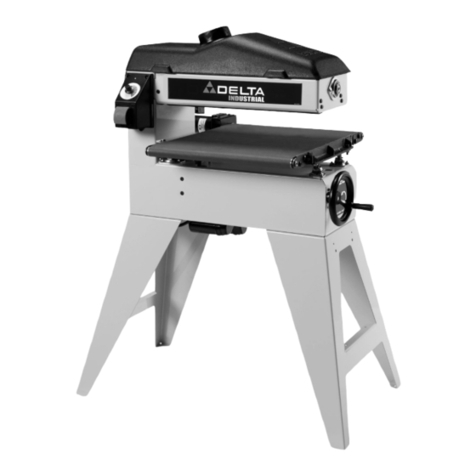
Delta
Delta 31-250 User manual
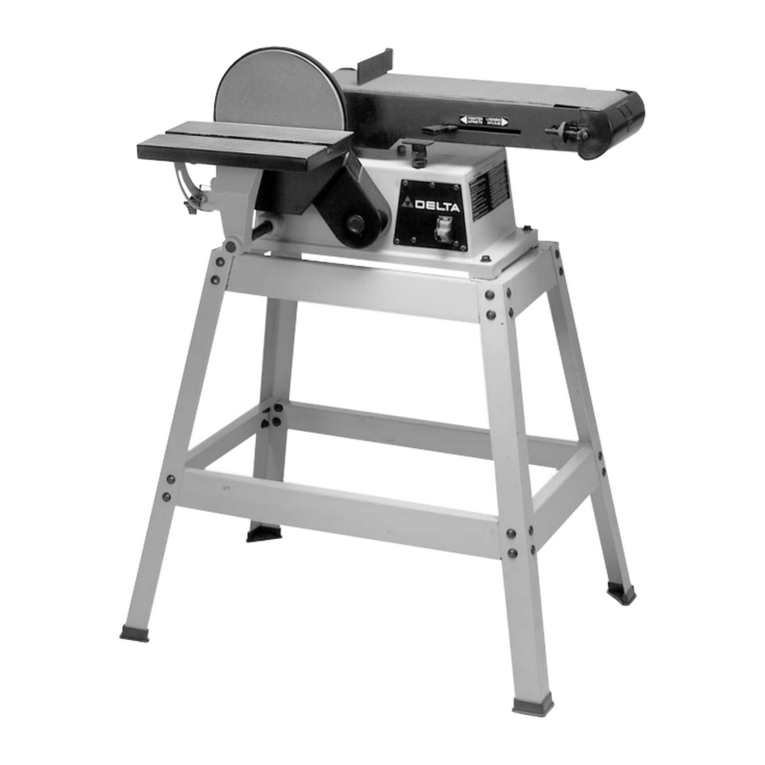
Delta
Delta 31-695 User manual
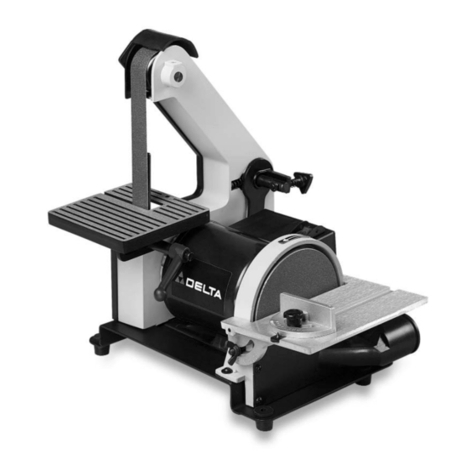
Delta
Delta 31-080 User manual

Delta
Delta (Model 31-300) User manual

Delta
Delta SA180 User manual
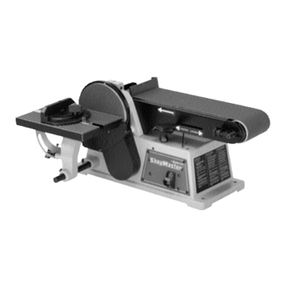
Delta
Delta ShopMaster 491836-00 User manual
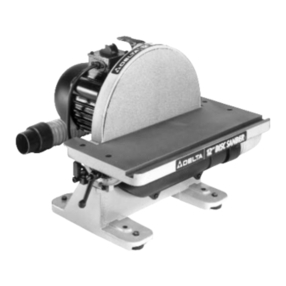
Delta
Delta 31-120 User manual

Delta
Delta ShopMaster SA446 User manual

Delta
Delta 31-260X User manual

Delta
Delta 1'' BELT SANDER 31-050 User manual
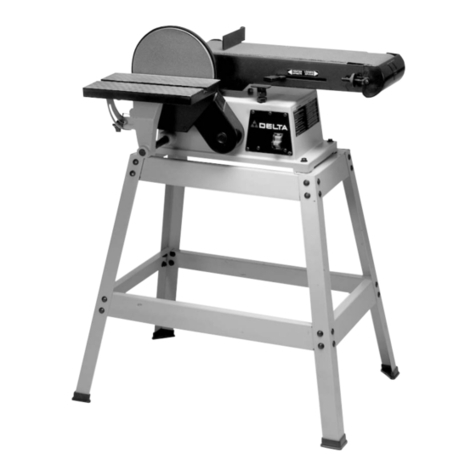
Delta
Delta 31-695 User manual

Delta
Delta 31-750 User manual
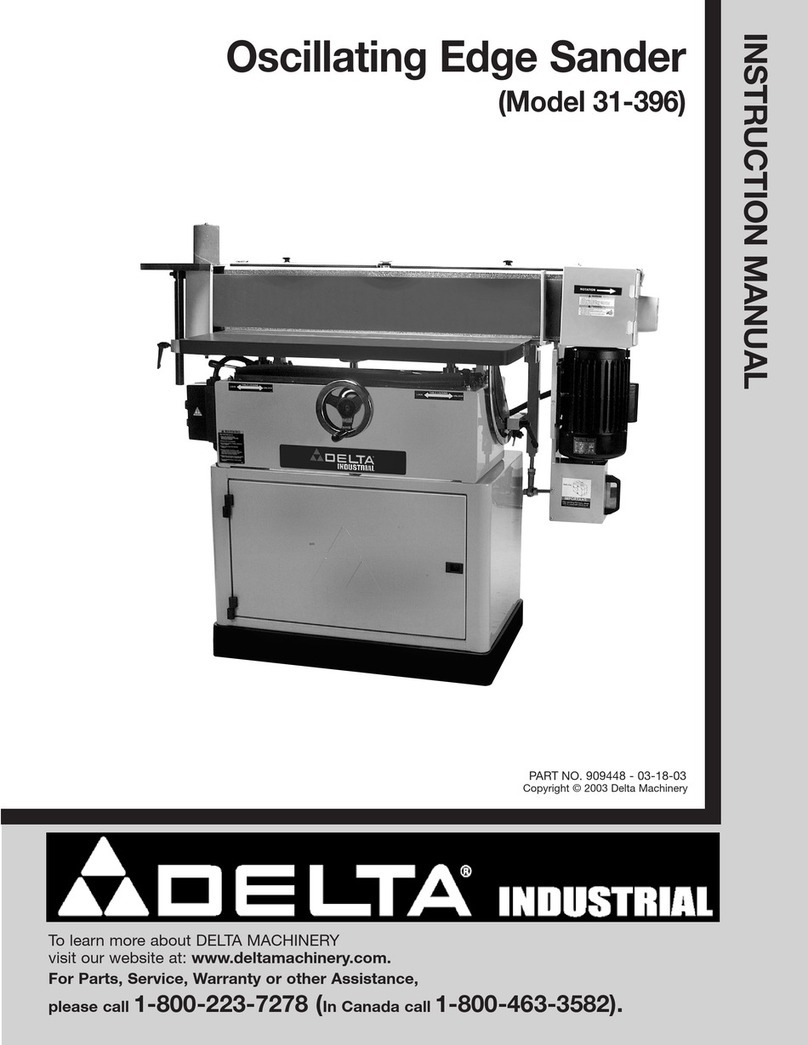
Delta
Delta 31-396 User manual

Delta
Delta 31-483 Service manual

Delta
Delta ShopMaster SA446 User manual

Delta
Delta 31-695 User manual

Delta
Delta 31-481 Service manual

Delta
Delta 31-495 User manual
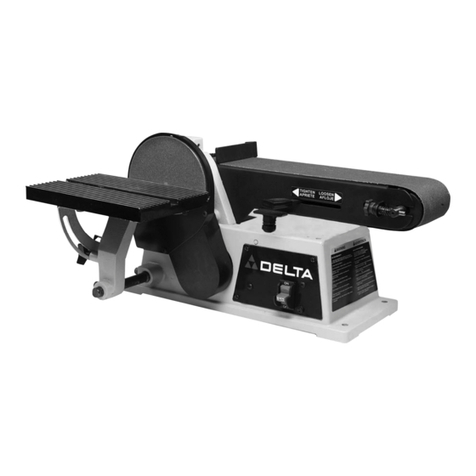
Delta
Delta 31-460 User manual
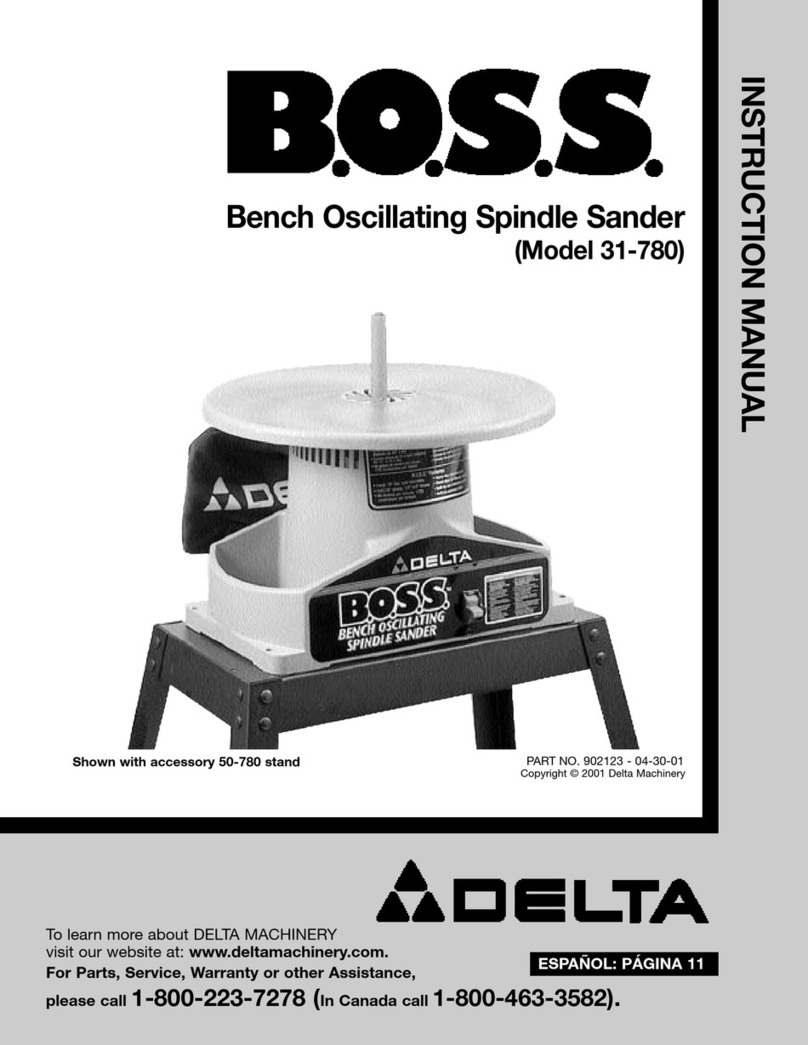
Delta
Delta 31-780 User manual


